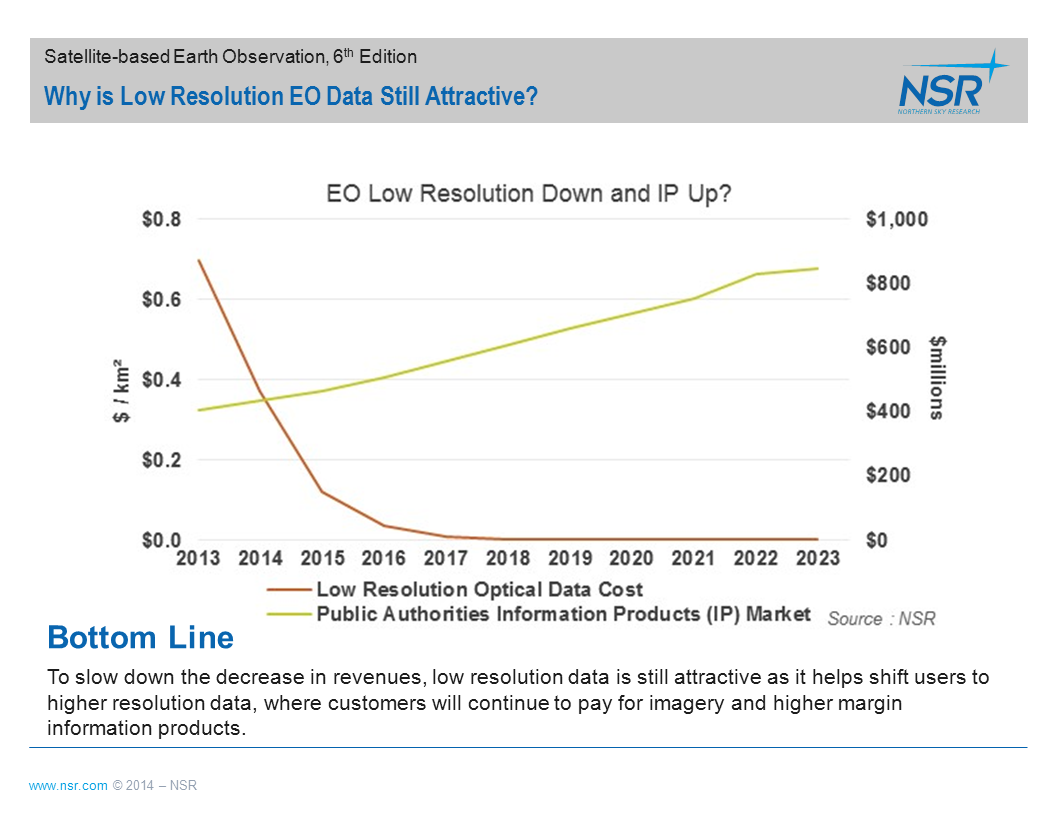|
Why is Low Resolution EO Data Still Attractive?
Dec 1st, 2014 by
Claude Rousseau, NSR
With Airbus Defence and Space announcing it will
add DMCii satellite imagery to its portfolio, and add up to 10
million km2 of data per day, one has to wonder where
the incentive is to offer more low resolution imagery. The
question is central since this market will face the frontal
assault of free data from various government programs in the
coming years.
As NSR indicated in its recently released
Satellite-Based Earth Observation, 6th
Edition report, the low-resolution EO data market will no
longer be viable in the not-too-distant future as very-high and
high-resolution imagery types take hold. So is the ADS
move to broaden its portfolio useless?
Not really, as there are still a large number of
customers that require the high-revisit and large swath products
that this type of data provides before customers no longer want
to pay for low resolution imagery. Even at 22 m
resolution, applications such as vegetation monitoring,
agriculture, change detection and forestry (to name a few) are
key targets for low resolution data.
And as with the recently announced teaming
agreement between Deimos, Dauria Aerospace, EIAST and BSEIT, who
together will offer EO satellite capacity ranging from 75 cm to
20 m from 9 spacecraft, the move makes sense as ADS can offer a
one-stop-shop for a variety of users for diverse applications
with both SAR and optical satellite data starting with sub-meter
resolution data. Furthermore, NSR estimates the agreement gives
ADS more than 70% market share in the low resolution data
market, thus deep reach in a fairly large and diverse market.
But with the advent of high-resolution imagery,
coupled with the blitz to free low resolution data via the
Sentinel program, will mean that to avoid being left out in the
cold, the operators’ strategy has to be focused on attracting
current and new users of low res data with good quality and
additional services. This will allow them to get familiar
with their products and then help the migration to medium- and
higher resolution datasets that users are still ready to pay
for.

The other side of the business that operators have
certainly looked at is that low resolution data imagery is
plentiful in the Public Authorities market, a vertical that is
expected to grow to more than $1.4 B in 2023 with more than half
of revenues coming from information products (IP). Getting
specialized skills for these is the undercurrent of IP and
expertise has a price, needs strong knowledge of local
conditions to extract valuable information and is on an upward
slope. The growth in this part of the market will be even
more pronounced with higher resolution data sets.
Bottom Line
As more free low resolution EO data becomes
available, the market will continue to see negative side-effects
even for medium resolution data prices. To slow down the
decrease in revenues, low resolution data is still attractive as
it helps shift users to higher resolution data, where customers
will continue to pay for imagery and higher margin information
products.
|